Post-Traumatic Stress Disorder among Abused Victims
VerifiedAdded on 2023/01/11
|11
|4320
|57
AI Summary
This article explores the concept of post-traumatic stress disorder (PTSD) among abused victims. It discusses the symptoms, types, and diagnosis of PTSD, as well as the impact on health and daily life. The article also highlights the rationale for group intervention and provides an evaluation of its effectiveness. Find comprehensive study material on this topic at Desklib.
Contribute Materials
Your contribution can guide someone’s learning journey. Share your
documents today.
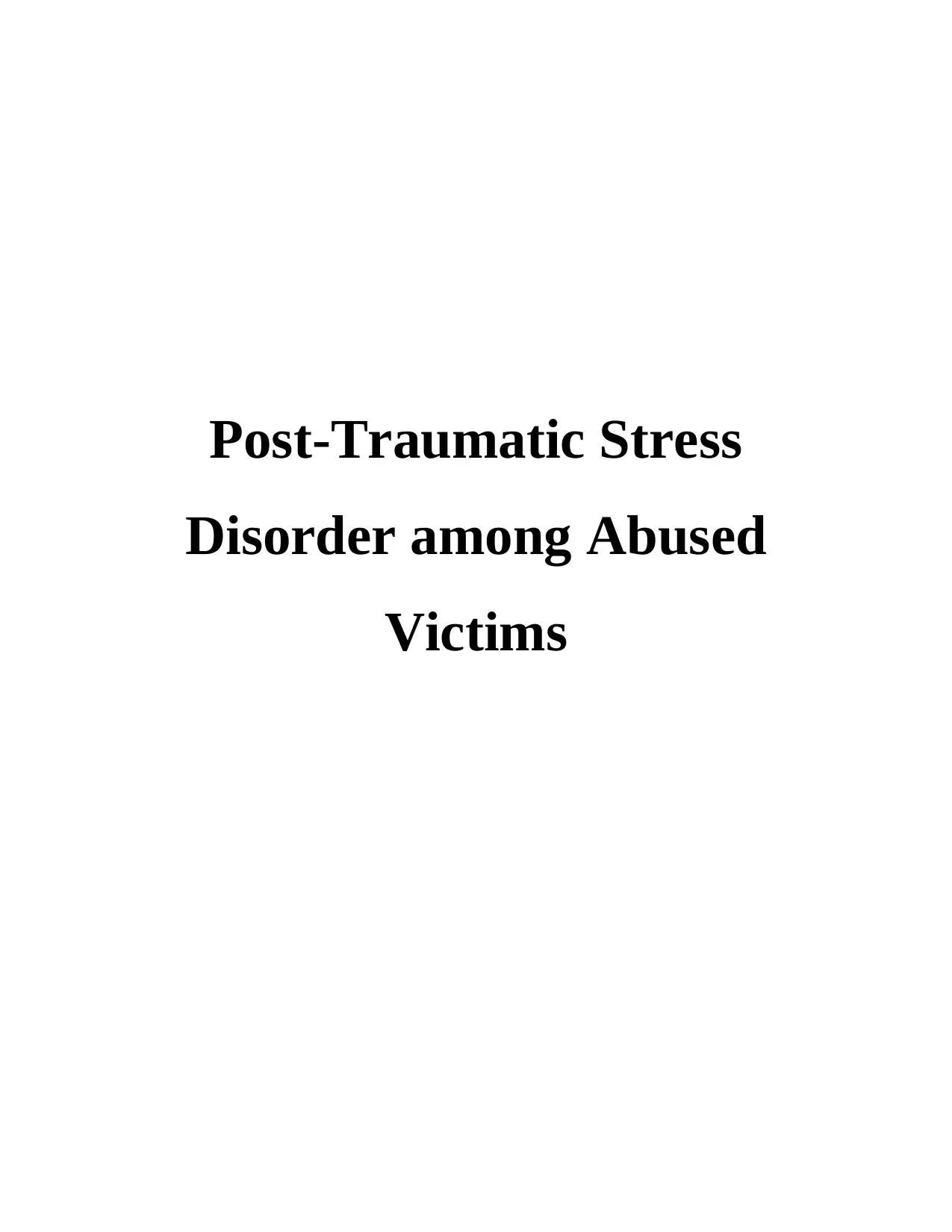
Post-Traumatic Stress
Disorder among Abused
Victims
Disorder among Abused
Victims
Secure Best Marks with AI Grader
Need help grading? Try our AI Grader for instant feedback on your assignments.
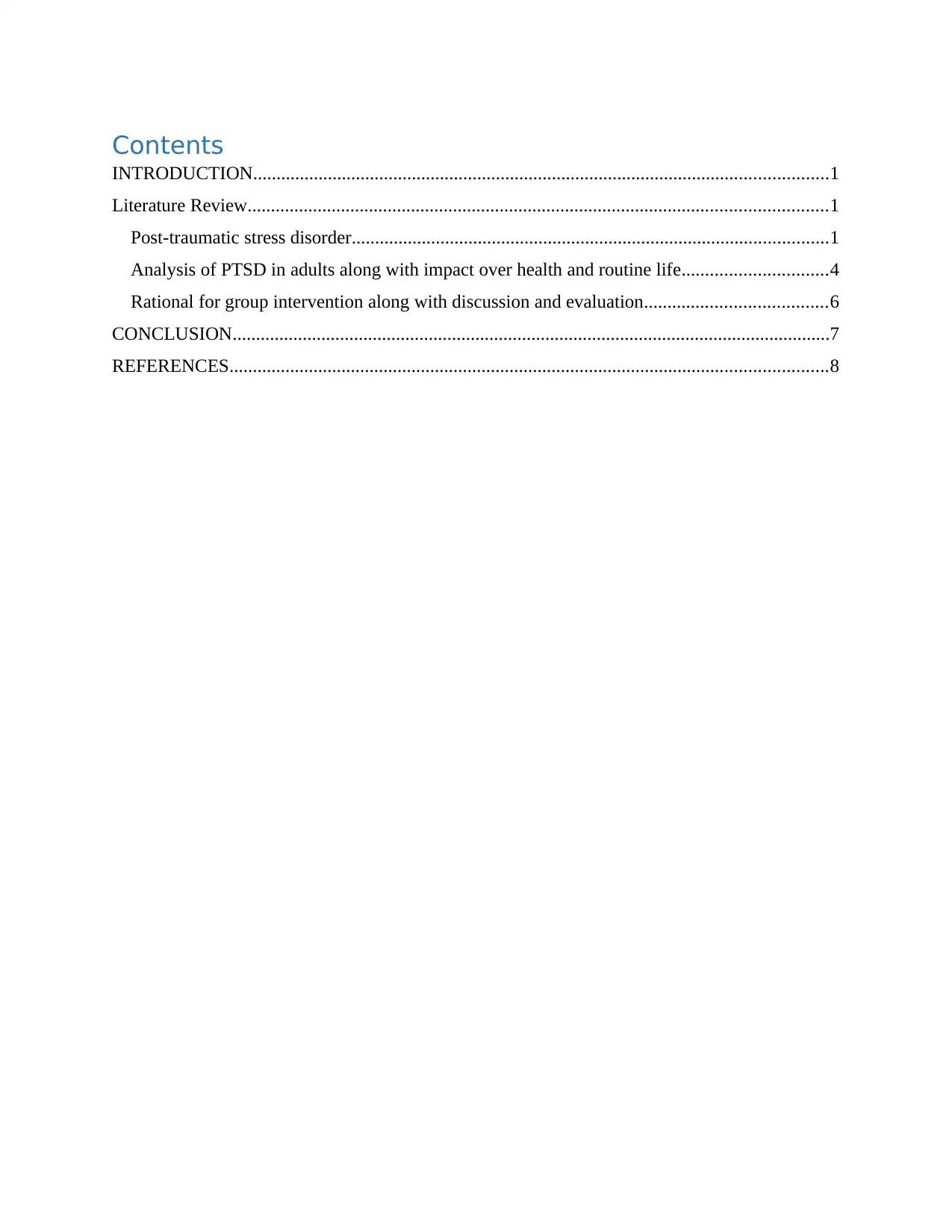
Contents
INTRODUCTION...........................................................................................................................1
Literature Review............................................................................................................................1
Post-traumatic stress disorder......................................................................................................1
Analysis of PTSD in adults along with impact over health and routine life...............................4
Rational for group intervention along with discussion and evaluation.......................................6
CONCLUSION................................................................................................................................7
REFERENCES................................................................................................................................8
INTRODUCTION...........................................................................................................................1
Literature Review............................................................................................................................1
Post-traumatic stress disorder......................................................................................................1
Analysis of PTSD in adults along with impact over health and routine life...............................4
Rational for group intervention along with discussion and evaluation.......................................6
CONCLUSION................................................................................................................................7
REFERENCES................................................................................................................................8
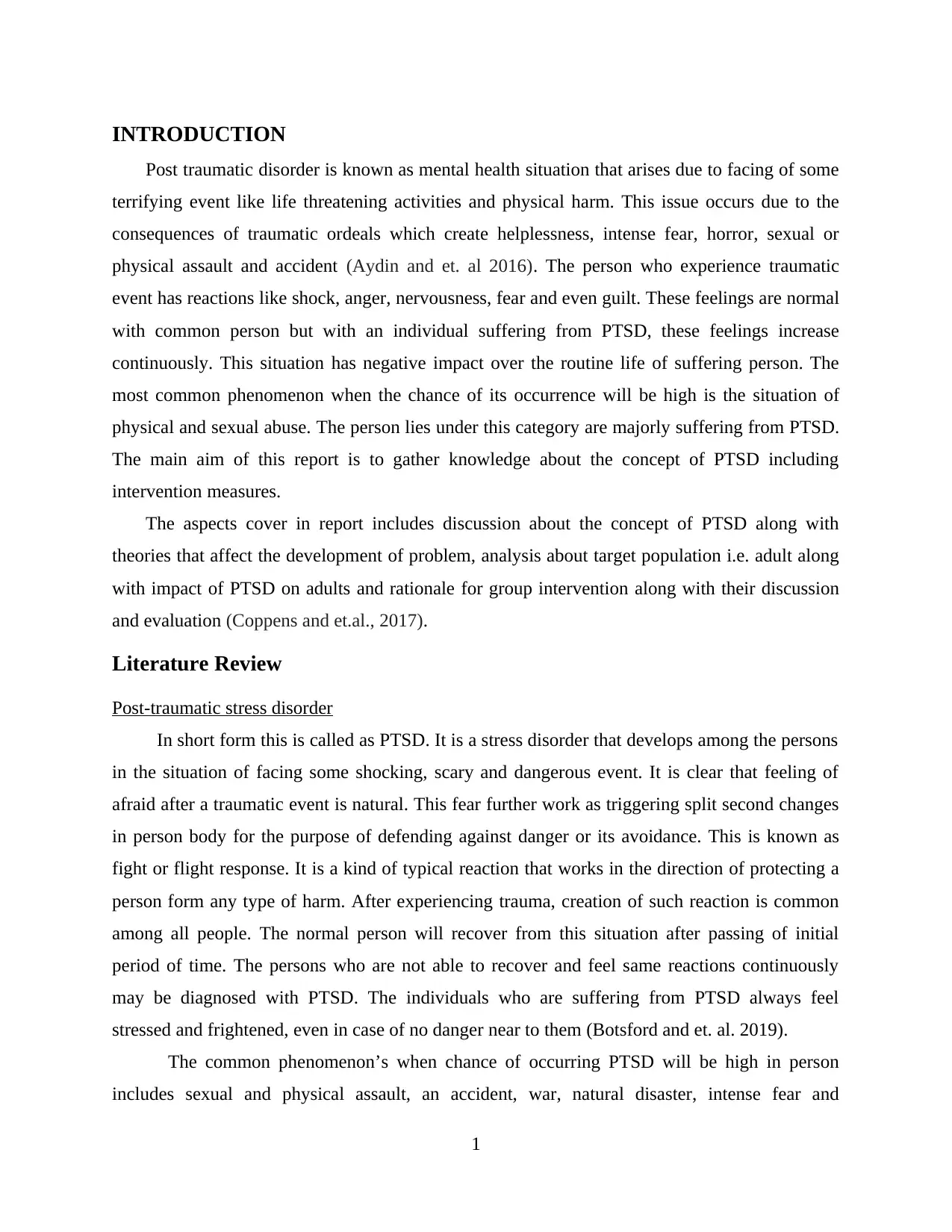
INTRODUCTION
Post traumatic disorder is known as mental health situation that arises due to facing of some
terrifying event like life threatening activities and physical harm. This issue occurs due to the
consequences of traumatic ordeals which create helplessness, intense fear, horror, sexual or
physical assault and accident (Aydin and et. al 2016). The person who experience traumatic
event has reactions like shock, anger, nervousness, fear and even guilt. These feelings are normal
with common person but with an individual suffering from PTSD, these feelings increase
continuously. This situation has negative impact over the routine life of suffering person. The
most common phenomenon when the chance of its occurrence will be high is the situation of
physical and sexual abuse. The person lies under this category are majorly suffering from PTSD.
The main aim of this report is to gather knowledge about the concept of PTSD including
intervention measures.
The aspects cover in report includes discussion about the concept of PTSD along with
theories that affect the development of problem, analysis about target population i.e. adult along
with impact of PTSD on adults and rationale for group intervention along with their discussion
and evaluation (Coppens and et.al., 2017).
Literature Review
Post-traumatic stress disorder
In short form this is called as PTSD. It is a stress disorder that develops among the persons
in the situation of facing some shocking, scary and dangerous event. It is clear that feeling of
afraid after a traumatic event is natural. This fear further work as triggering split second changes
in person body for the purpose of defending against danger or its avoidance. This is known as
fight or flight response. It is a kind of typical reaction that works in the direction of protecting a
person form any type of harm. After experiencing trauma, creation of such reaction is common
among all people. The normal person will recover from this situation after passing of initial
period of time. The persons who are not able to recover and feel same reactions continuously
may be diagnosed with PTSD. The individuals who are suffering from PTSD always feel
stressed and frightened, even in case of no danger near to them (Botsford and et. al. 2019).
The common phenomenon’s when chance of occurring PTSD will be high in person
includes sexual and physical assault, an accident, war, natural disaster, intense fear and
1
Post traumatic disorder is known as mental health situation that arises due to facing of some
terrifying event like life threatening activities and physical harm. This issue occurs due to the
consequences of traumatic ordeals which create helplessness, intense fear, horror, sexual or
physical assault and accident (Aydin and et. al 2016). The person who experience traumatic
event has reactions like shock, anger, nervousness, fear and even guilt. These feelings are normal
with common person but with an individual suffering from PTSD, these feelings increase
continuously. This situation has negative impact over the routine life of suffering person. The
most common phenomenon when the chance of its occurrence will be high is the situation of
physical and sexual abuse. The person lies under this category are majorly suffering from PTSD.
The main aim of this report is to gather knowledge about the concept of PTSD including
intervention measures.
The aspects cover in report includes discussion about the concept of PTSD along with
theories that affect the development of problem, analysis about target population i.e. adult along
with impact of PTSD on adults and rationale for group intervention along with their discussion
and evaluation (Coppens and et.al., 2017).
Literature Review
Post-traumatic stress disorder
In short form this is called as PTSD. It is a stress disorder that develops among the persons
in the situation of facing some shocking, scary and dangerous event. It is clear that feeling of
afraid after a traumatic event is natural. This fear further work as triggering split second changes
in person body for the purpose of defending against danger or its avoidance. This is known as
fight or flight response. It is a kind of typical reaction that works in the direction of protecting a
person form any type of harm. After experiencing trauma, creation of such reaction is common
among all people. The normal person will recover from this situation after passing of initial
period of time. The persons who are not able to recover and feel same reactions continuously
may be diagnosed with PTSD. The individuals who are suffering from PTSD always feel
stressed and frightened, even in case of no danger near to them (Botsford and et. al. 2019).
The common phenomenon’s when chance of occurring PTSD will be high in person
includes sexual and physical assault, an accident, war, natural disaster, intense fear and
1
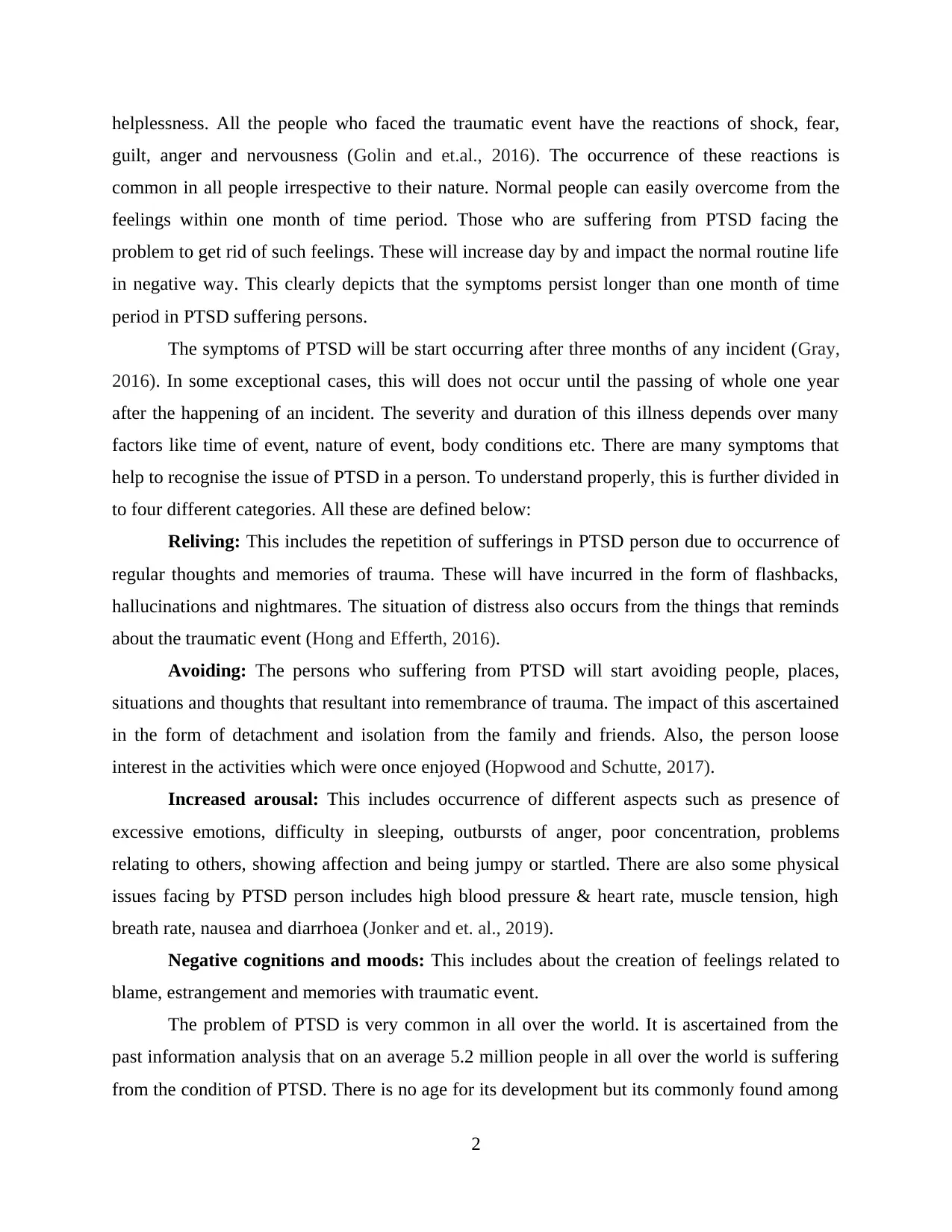
helplessness. All the people who faced the traumatic event have the reactions of shock, fear,
guilt, anger and nervousness (Golin and et.al., 2016). The occurrence of these reactions is
common in all people irrespective to their nature. Normal people can easily overcome from the
feelings within one month of time period. Those who are suffering from PTSD facing the
problem to get rid of such feelings. These will increase day by and impact the normal routine life
in negative way. This clearly depicts that the symptoms persist longer than one month of time
period in PTSD suffering persons.
The symptoms of PTSD will be start occurring after three months of any incident (Gray,
2016). In some exceptional cases, this will does not occur until the passing of whole one year
after the happening of an incident. The severity and duration of this illness depends over many
factors like time of event, nature of event, body conditions etc. There are many symptoms that
help to recognise the issue of PTSD in a person. To understand properly, this is further divided in
to four different categories. All these are defined below:
Reliving: This includes the repetition of sufferings in PTSD person due to occurrence of
regular thoughts and memories of trauma. These will have incurred in the form of flashbacks,
hallucinations and nightmares. The situation of distress also occurs from the things that reminds
about the traumatic event (Hong and Efferth, 2016).
Avoiding: The persons who suffering from PTSD will start avoiding people, places,
situations and thoughts that resultant into remembrance of trauma. The impact of this ascertained
in the form of detachment and isolation from the family and friends. Also, the person loose
interest in the activities which were once enjoyed (Hopwood and Schutte, 2017).
Increased arousal: This includes occurrence of different aspects such as presence of
excessive emotions, difficulty in sleeping, outbursts of anger, poor concentration, problems
relating to others, showing affection and being jumpy or startled. There are also some physical
issues facing by PTSD person includes high blood pressure & heart rate, muscle tension, high
breath rate, nausea and diarrhoea (Jonker and et. al., 2019).
Negative cognitions and moods: This includes about the creation of feelings related to
blame, estrangement and memories with traumatic event.
The problem of PTSD is very common in all over the world. It is ascertained from the
past information analysis that on an average 5.2 million people in all over the world is suffering
from the condition of PTSD. There is no age for its development but its commonly found among
2
guilt, anger and nervousness (Golin and et.al., 2016). The occurrence of these reactions is
common in all people irrespective to their nature. Normal people can easily overcome from the
feelings within one month of time period. Those who are suffering from PTSD facing the
problem to get rid of such feelings. These will increase day by and impact the normal routine life
in negative way. This clearly depicts that the symptoms persist longer than one month of time
period in PTSD suffering persons.
The symptoms of PTSD will be start occurring after three months of any incident (Gray,
2016). In some exceptional cases, this will does not occur until the passing of whole one year
after the happening of an incident. The severity and duration of this illness depends over many
factors like time of event, nature of event, body conditions etc. There are many symptoms that
help to recognise the issue of PTSD in a person. To understand properly, this is further divided in
to four different categories. All these are defined below:
Reliving: This includes the repetition of sufferings in PTSD person due to occurrence of
regular thoughts and memories of trauma. These will have incurred in the form of flashbacks,
hallucinations and nightmares. The situation of distress also occurs from the things that reminds
about the traumatic event (Hong and Efferth, 2016).
Avoiding: The persons who suffering from PTSD will start avoiding people, places,
situations and thoughts that resultant into remembrance of trauma. The impact of this ascertained
in the form of detachment and isolation from the family and friends. Also, the person loose
interest in the activities which were once enjoyed (Hopwood and Schutte, 2017).
Increased arousal: This includes occurrence of different aspects such as presence of
excessive emotions, difficulty in sleeping, outbursts of anger, poor concentration, problems
relating to others, showing affection and being jumpy or startled. There are also some physical
issues facing by PTSD person includes high blood pressure & heart rate, muscle tension, high
breath rate, nausea and diarrhoea (Jonker and et. al., 2019).
Negative cognitions and moods: This includes about the creation of feelings related to
blame, estrangement and memories with traumatic event.
The problem of PTSD is very common in all over the world. It is ascertained from the
past information analysis that on an average 5.2 million people in all over the world is suffering
from the condition of PTSD. There is no age for its development but its commonly found among
2
Secure Best Marks with AI Grader
Need help grading? Try our AI Grader for instant feedback on your assignments.
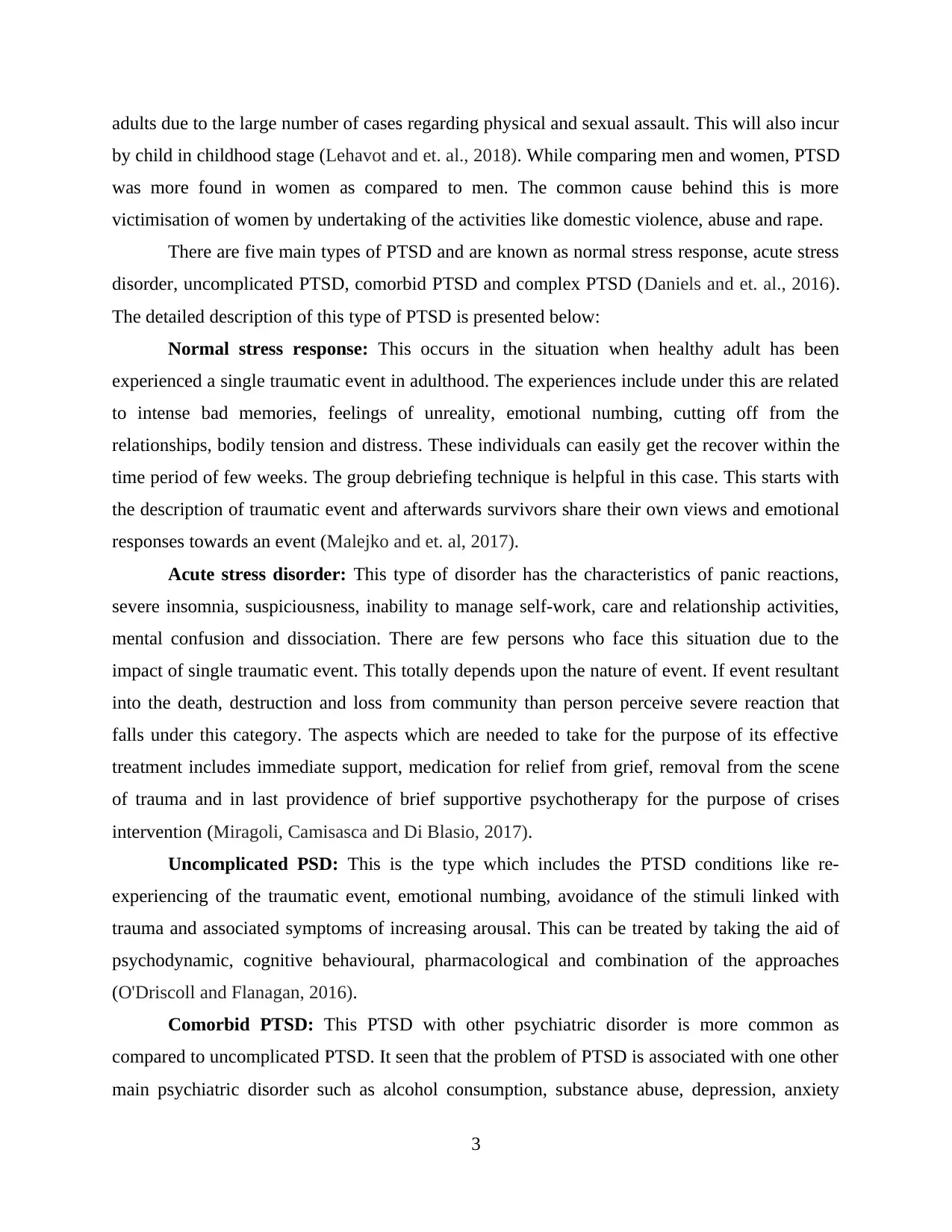
adults due to the large number of cases regarding physical and sexual assault. This will also incur
by child in childhood stage (Lehavot and et. al., 2018). While comparing men and women, PTSD
was more found in women as compared to men. The common cause behind this is more
victimisation of women by undertaking of the activities like domestic violence, abuse and rape.
There are five main types of PTSD and are known as normal stress response, acute stress
disorder, uncomplicated PTSD, comorbid PTSD and complex PTSD (Daniels and et. al., 2016).
The detailed description of this type of PTSD is presented below:
Normal stress response: This occurs in the situation when healthy adult has been
experienced a single traumatic event in adulthood. The experiences include under this are related
to intense bad memories, feelings of unreality, emotional numbing, cutting off from the
relationships, bodily tension and distress. These individuals can easily get the recover within the
time period of few weeks. The group debriefing technique is helpful in this case. This starts with
the description of traumatic event and afterwards survivors share their own views and emotional
responses towards an event (Malejko and et. al, 2017).
Acute stress disorder: This type of disorder has the characteristics of panic reactions,
severe insomnia, suspiciousness, inability to manage self-work, care and relationship activities,
mental confusion and dissociation. There are few persons who face this situation due to the
impact of single traumatic event. This totally depends upon the nature of event. If event resultant
into the death, destruction and loss from community than person perceive severe reaction that
falls under this category. The aspects which are needed to take for the purpose of its effective
treatment includes immediate support, medication for relief from grief, removal from the scene
of trauma and in last providence of brief supportive psychotherapy for the purpose of crises
intervention (Miragoli, Camisasca and Di Blasio, 2017).
Uncomplicated PSD: This is the type which includes the PTSD conditions like re-
experiencing of the traumatic event, emotional numbing, avoidance of the stimuli linked with
trauma and associated symptoms of increasing arousal. This can be treated by taking the aid of
psychodynamic, cognitive behavioural, pharmacological and combination of the approaches
(O'Driscoll and Flanagan, 2016).
Comorbid PTSD: This PTSD with other psychiatric disorder is more common as
compared to uncomplicated PTSD. It seen that the problem of PTSD is associated with one other
main psychiatric disorder such as alcohol consumption, substance abuse, depression, anxiety
3
by child in childhood stage (Lehavot and et. al., 2018). While comparing men and women, PTSD
was more found in women as compared to men. The common cause behind this is more
victimisation of women by undertaking of the activities like domestic violence, abuse and rape.
There are five main types of PTSD and are known as normal stress response, acute stress
disorder, uncomplicated PTSD, comorbid PTSD and complex PTSD (Daniels and et. al., 2016).
The detailed description of this type of PTSD is presented below:
Normal stress response: This occurs in the situation when healthy adult has been
experienced a single traumatic event in adulthood. The experiences include under this are related
to intense bad memories, feelings of unreality, emotional numbing, cutting off from the
relationships, bodily tension and distress. These individuals can easily get the recover within the
time period of few weeks. The group debriefing technique is helpful in this case. This starts with
the description of traumatic event and afterwards survivors share their own views and emotional
responses towards an event (Malejko and et. al, 2017).
Acute stress disorder: This type of disorder has the characteristics of panic reactions,
severe insomnia, suspiciousness, inability to manage self-work, care and relationship activities,
mental confusion and dissociation. There are few persons who face this situation due to the
impact of single traumatic event. This totally depends upon the nature of event. If event resultant
into the death, destruction and loss from community than person perceive severe reaction that
falls under this category. The aspects which are needed to take for the purpose of its effective
treatment includes immediate support, medication for relief from grief, removal from the scene
of trauma and in last providence of brief supportive psychotherapy for the purpose of crises
intervention (Miragoli, Camisasca and Di Blasio, 2017).
Uncomplicated PSD: This is the type which includes the PTSD conditions like re-
experiencing of the traumatic event, emotional numbing, avoidance of the stimuli linked with
trauma and associated symptoms of increasing arousal. This can be treated by taking the aid of
psychodynamic, cognitive behavioural, pharmacological and combination of the approaches
(O'Driscoll and Flanagan, 2016).
Comorbid PTSD: This PTSD with other psychiatric disorder is more common as
compared to uncomplicated PTSD. It seen that the problem of PTSD is associated with one other
main psychiatric disorder such as alcohol consumption, substance abuse, depression, anxiety
3
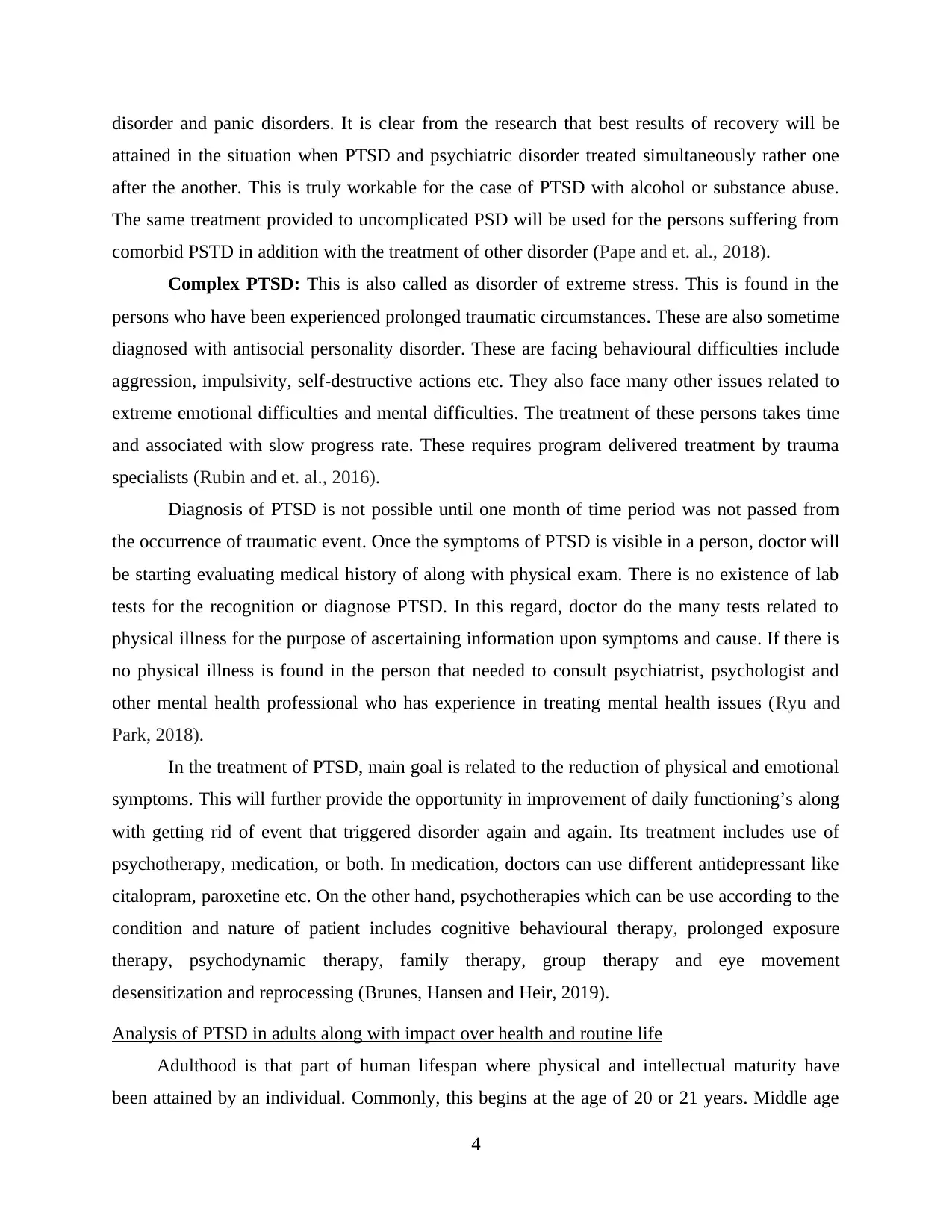
disorder and panic disorders. It is clear from the research that best results of recovery will be
attained in the situation when PTSD and psychiatric disorder treated simultaneously rather one
after the another. This is truly workable for the case of PTSD with alcohol or substance abuse.
The same treatment provided to uncomplicated PSD will be used for the persons suffering from
comorbid PSTD in addition with the treatment of other disorder (Pape and et. al., 2018).
Complex PTSD: This is also called as disorder of extreme stress. This is found in the
persons who have been experienced prolonged traumatic circumstances. These are also sometime
diagnosed with antisocial personality disorder. These are facing behavioural difficulties include
aggression, impulsivity, self-destructive actions etc. They also face many other issues related to
extreme emotional difficulties and mental difficulties. The treatment of these persons takes time
and associated with slow progress rate. These requires program delivered treatment by trauma
specialists (Rubin and et. al., 2016).
Diagnosis of PTSD is not possible until one month of time period was not passed from
the occurrence of traumatic event. Once the symptoms of PTSD is visible in a person, doctor will
be starting evaluating medical history of along with physical exam. There is no existence of lab
tests for the recognition or diagnose PTSD. In this regard, doctor do the many tests related to
physical illness for the purpose of ascertaining information upon symptoms and cause. If there is
no physical illness is found in the person that needed to consult psychiatrist, psychologist and
other mental health professional who has experience in treating mental health issues (Ryu and
Park, 2018).
In the treatment of PTSD, main goal is related to the reduction of physical and emotional
symptoms. This will further provide the opportunity in improvement of daily functioning’s along
with getting rid of event that triggered disorder again and again. Its treatment includes use of
psychotherapy, medication, or both. In medication, doctors can use different antidepressant like
citalopram, paroxetine etc. On the other hand, psychotherapies which can be use according to the
condition and nature of patient includes cognitive behavioural therapy, prolonged exposure
therapy, psychodynamic therapy, family therapy, group therapy and eye movement
desensitization and reprocessing (Brunes, Hansen and Heir, 2019).
Analysis of PTSD in adults along with impact over health and routine life
Adulthood is that part of human lifespan where physical and intellectual maturity have
been attained by an individual. Commonly, this begins at the age of 20 or 21 years. Middle age
4
attained in the situation when PTSD and psychiatric disorder treated simultaneously rather one
after the another. This is truly workable for the case of PTSD with alcohol or substance abuse.
The same treatment provided to uncomplicated PSD will be used for the persons suffering from
comorbid PSTD in addition with the treatment of other disorder (Pape and et. al., 2018).
Complex PTSD: This is also called as disorder of extreme stress. This is found in the
persons who have been experienced prolonged traumatic circumstances. These are also sometime
diagnosed with antisocial personality disorder. These are facing behavioural difficulties include
aggression, impulsivity, self-destructive actions etc. They also face many other issues related to
extreme emotional difficulties and mental difficulties. The treatment of these persons takes time
and associated with slow progress rate. These requires program delivered treatment by trauma
specialists (Rubin and et. al., 2016).
Diagnosis of PTSD is not possible until one month of time period was not passed from
the occurrence of traumatic event. Once the symptoms of PTSD is visible in a person, doctor will
be starting evaluating medical history of along with physical exam. There is no existence of lab
tests for the recognition or diagnose PTSD. In this regard, doctor do the many tests related to
physical illness for the purpose of ascertaining information upon symptoms and cause. If there is
no physical illness is found in the person that needed to consult psychiatrist, psychologist and
other mental health professional who has experience in treating mental health issues (Ryu and
Park, 2018).
In the treatment of PTSD, main goal is related to the reduction of physical and emotional
symptoms. This will further provide the opportunity in improvement of daily functioning’s along
with getting rid of event that triggered disorder again and again. Its treatment includes use of
psychotherapy, medication, or both. In medication, doctors can use different antidepressant like
citalopram, paroxetine etc. On the other hand, psychotherapies which can be use according to the
condition and nature of patient includes cognitive behavioural therapy, prolonged exposure
therapy, psychodynamic therapy, family therapy, group therapy and eye movement
desensitization and reprocessing (Brunes, Hansen and Heir, 2019).
Analysis of PTSD in adults along with impact over health and routine life
Adulthood is that part of human lifespan where physical and intellectual maturity have
been attained by an individual. Commonly, this begins at the age of 20 or 21 years. Middle age
4
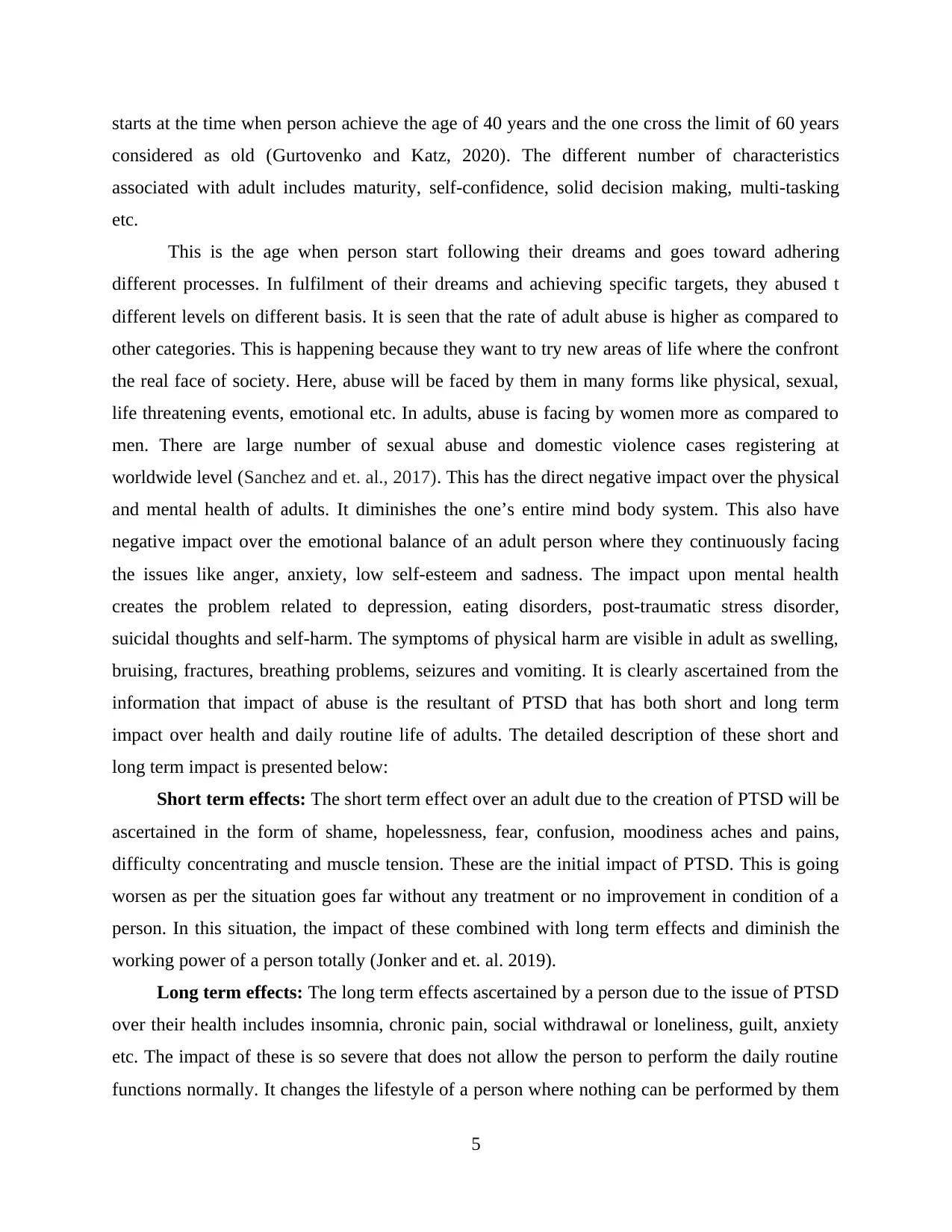
starts at the time when person achieve the age of 40 years and the one cross the limit of 60 years
considered as old (Gurtovenko and Katz, 2020). The different number of characteristics
associated with adult includes maturity, self-confidence, solid decision making, multi-tasking
etc.
This is the age when person start following their dreams and goes toward adhering
different processes. In fulfilment of their dreams and achieving specific targets, they abused t
different levels on different basis. It is seen that the rate of adult abuse is higher as compared to
other categories. This is happening because they want to try new areas of life where the confront
the real face of society. Here, abuse will be faced by them in many forms like physical, sexual,
life threatening events, emotional etc. In adults, abuse is facing by women more as compared to
men. There are large number of sexual abuse and domestic violence cases registering at
worldwide level (Sanchez and et. al., 2017). This has the direct negative impact over the physical
and mental health of adults. It diminishes the one’s entire mind body system. This also have
negative impact over the emotional balance of an adult person where they continuously facing
the issues like anger, anxiety, low self-esteem and sadness. The impact upon mental health
creates the problem related to depression, eating disorders, post-traumatic stress disorder,
suicidal thoughts and self-harm. The symptoms of physical harm are visible in adult as swelling,
bruising, fractures, breathing problems, seizures and vomiting. It is clearly ascertained from the
information that impact of abuse is the resultant of PTSD that has both short and long term
impact over health and daily routine life of adults. The detailed description of these short and
long term impact is presented below:
Short term effects: The short term effect over an adult due to the creation of PTSD will be
ascertained in the form of shame, hopelessness, fear, confusion, moodiness aches and pains,
difficulty concentrating and muscle tension. These are the initial impact of PTSD. This is going
worsen as per the situation goes far without any treatment or no improvement in condition of a
person. In this situation, the impact of these combined with long term effects and diminish the
working power of a person totally (Jonker and et. al. 2019).
Long term effects: The long term effects ascertained by a person due to the issue of PTSD
over their health includes insomnia, chronic pain, social withdrawal or loneliness, guilt, anxiety
etc. The impact of these is so severe that does not allow the person to perform the daily routine
functions normally. It changes the lifestyle of a person where nothing can be performed by them
5
considered as old (Gurtovenko and Katz, 2020). The different number of characteristics
associated with adult includes maturity, self-confidence, solid decision making, multi-tasking
etc.
This is the age when person start following their dreams and goes toward adhering
different processes. In fulfilment of their dreams and achieving specific targets, they abused t
different levels on different basis. It is seen that the rate of adult abuse is higher as compared to
other categories. This is happening because they want to try new areas of life where the confront
the real face of society. Here, abuse will be faced by them in many forms like physical, sexual,
life threatening events, emotional etc. In adults, abuse is facing by women more as compared to
men. There are large number of sexual abuse and domestic violence cases registering at
worldwide level (Sanchez and et. al., 2017). This has the direct negative impact over the physical
and mental health of adults. It diminishes the one’s entire mind body system. This also have
negative impact over the emotional balance of an adult person where they continuously facing
the issues like anger, anxiety, low self-esteem and sadness. The impact upon mental health
creates the problem related to depression, eating disorders, post-traumatic stress disorder,
suicidal thoughts and self-harm. The symptoms of physical harm are visible in adult as swelling,
bruising, fractures, breathing problems, seizures and vomiting. It is clearly ascertained from the
information that impact of abuse is the resultant of PTSD that has both short and long term
impact over health and daily routine life of adults. The detailed description of these short and
long term impact is presented below:
Short term effects: The short term effect over an adult due to the creation of PTSD will be
ascertained in the form of shame, hopelessness, fear, confusion, moodiness aches and pains,
difficulty concentrating and muscle tension. These are the initial impact of PTSD. This is going
worsen as per the situation goes far without any treatment or no improvement in condition of a
person. In this situation, the impact of these combined with long term effects and diminish the
working power of a person totally (Jonker and et. al. 2019).
Long term effects: The long term effects ascertained by a person due to the issue of PTSD
over their health includes insomnia, chronic pain, social withdrawal or loneliness, guilt, anxiety
etc. The impact of these is so severe that does not allow the person to perform the daily routine
functions normally. It changes the lifestyle of a person where nothing can be performed by them
5
Paraphrase This Document
Need a fresh take? Get an instant paraphrase of this document with our AI Paraphraser
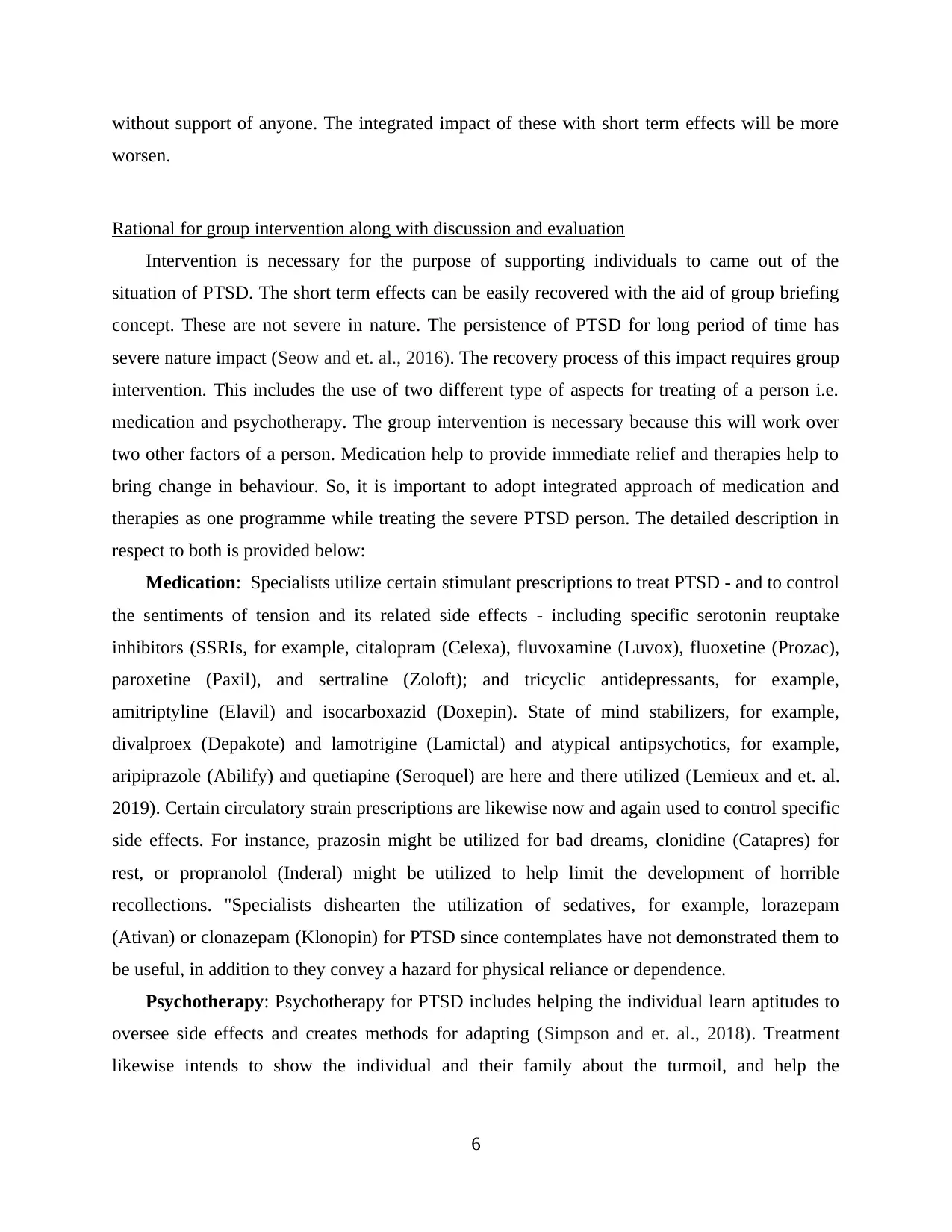
without support of anyone. The integrated impact of these with short term effects will be more
worsen.
Rational for group intervention along with discussion and evaluation
Intervention is necessary for the purpose of supporting individuals to came out of the
situation of PTSD. The short term effects can be easily recovered with the aid of group briefing
concept. These are not severe in nature. The persistence of PTSD for long period of time has
severe nature impact (Seow and et. al., 2016). The recovery process of this impact requires group
intervention. This includes the use of two different type of aspects for treating of a person i.e.
medication and psychotherapy. The group intervention is necessary because this will work over
two other factors of a person. Medication help to provide immediate relief and therapies help to
bring change in behaviour. So, it is important to adopt integrated approach of medication and
therapies as one programme while treating the severe PTSD person. The detailed description in
respect to both is provided below:
Medication: Specialists utilize certain stimulant prescriptions to treat PTSD - and to control
the sentiments of tension and its related side effects - including specific serotonin reuptake
inhibitors (SSRIs, for example, citalopram (Celexa), fluvoxamine (Luvox), fluoxetine (Prozac),
paroxetine (Paxil), and sertraline (Zoloft); and tricyclic antidepressants, for example,
amitriptyline (Elavil) and isocarboxazid (Doxepin). State of mind stabilizers, for example,
divalproex (Depakote) and lamotrigine (Lamictal) and atypical antipsychotics, for example,
aripiprazole (Abilify) and quetiapine (Seroquel) are here and there utilized (Lemieux and et. al.
2019). Certain circulatory strain prescriptions are likewise now and again used to control specific
side effects. For instance, prazosin might be utilized for bad dreams, clonidine (Catapres) for
rest, or propranolol (Inderal) might be utilized to help limit the development of horrible
recollections. "Specialists dishearten the utilization of sedatives, for example, lorazepam
(Ativan) or clonazepam (Klonopin) for PTSD since contemplates have not demonstrated them to
be useful, in addition to they convey a hazard for physical reliance or dependence.
Psychotherapy: Psychotherapy for PTSD includes helping the individual learn aptitudes to
oversee side effects and creates methods for adapting (Simpson and et. al., 2018). Treatment
likewise intends to show the individual and their family about the turmoil, and help the
6
worsen.
Rational for group intervention along with discussion and evaluation
Intervention is necessary for the purpose of supporting individuals to came out of the
situation of PTSD. The short term effects can be easily recovered with the aid of group briefing
concept. These are not severe in nature. The persistence of PTSD for long period of time has
severe nature impact (Seow and et. al., 2016). The recovery process of this impact requires group
intervention. This includes the use of two different type of aspects for treating of a person i.e.
medication and psychotherapy. The group intervention is necessary because this will work over
two other factors of a person. Medication help to provide immediate relief and therapies help to
bring change in behaviour. So, it is important to adopt integrated approach of medication and
therapies as one programme while treating the severe PTSD person. The detailed description in
respect to both is provided below:
Medication: Specialists utilize certain stimulant prescriptions to treat PTSD - and to control
the sentiments of tension and its related side effects - including specific serotonin reuptake
inhibitors (SSRIs, for example, citalopram (Celexa), fluvoxamine (Luvox), fluoxetine (Prozac),
paroxetine (Paxil), and sertraline (Zoloft); and tricyclic antidepressants, for example,
amitriptyline (Elavil) and isocarboxazid (Doxepin). State of mind stabilizers, for example,
divalproex (Depakote) and lamotrigine (Lamictal) and atypical antipsychotics, for example,
aripiprazole (Abilify) and quetiapine (Seroquel) are here and there utilized (Lemieux and et. al.
2019). Certain circulatory strain prescriptions are likewise now and again used to control specific
side effects. For instance, prazosin might be utilized for bad dreams, clonidine (Catapres) for
rest, or propranolol (Inderal) might be utilized to help limit the development of horrible
recollections. "Specialists dishearten the utilization of sedatives, for example, lorazepam
(Ativan) or clonazepam (Klonopin) for PTSD since contemplates have not demonstrated them to
be useful, in addition to they convey a hazard for physical reliance or dependence.
Psychotherapy: Psychotherapy for PTSD includes helping the individual learn aptitudes to
oversee side effects and creates methods for adapting (Simpson and et. al., 2018). Treatment
likewise intends to show the individual and their family about the turmoil, and help the
6
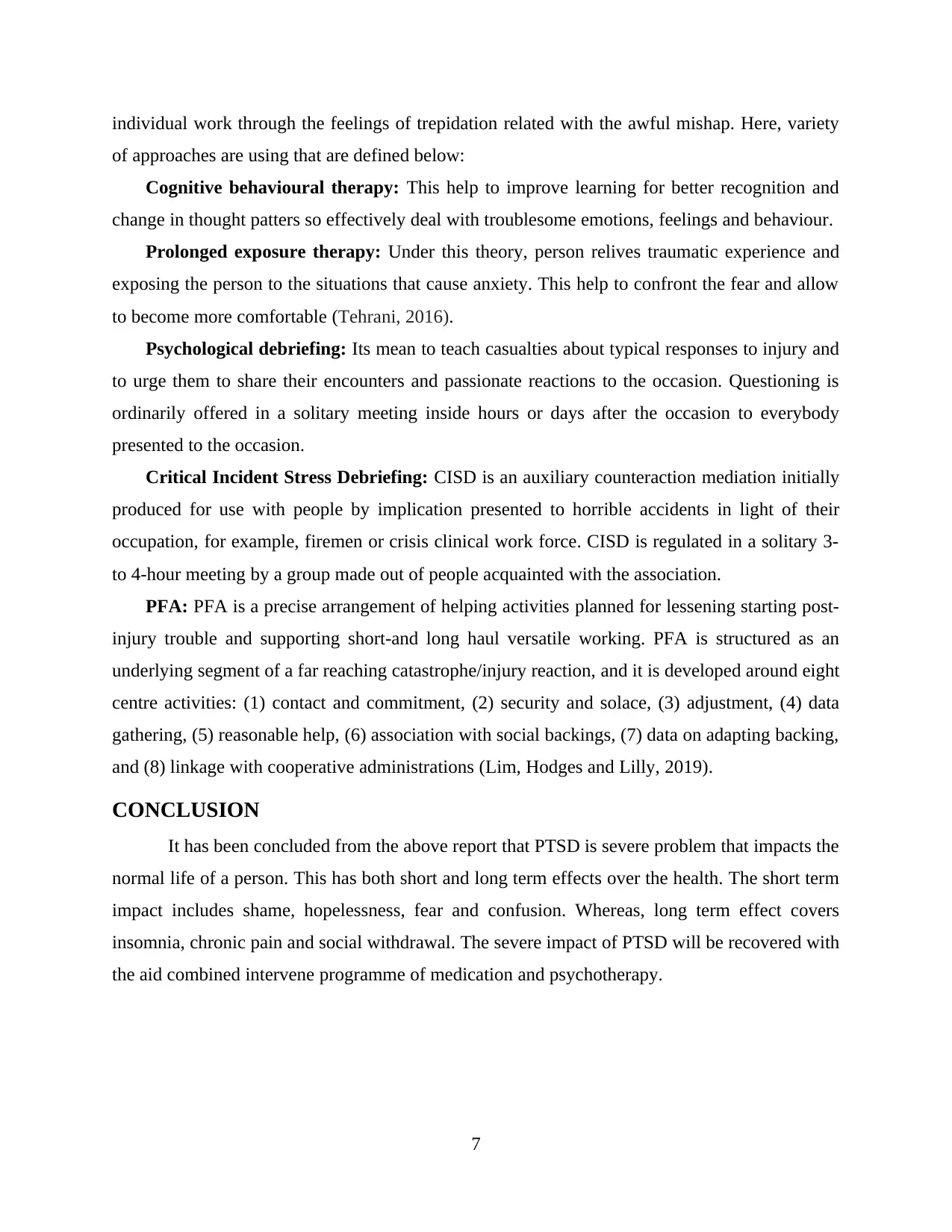
individual work through the feelings of trepidation related with the awful mishap. Here, variety
of approaches are using that are defined below:
Cognitive behavioural therapy: This help to improve learning for better recognition and
change in thought patters so effectively deal with troublesome emotions, feelings and behaviour.
Prolonged exposure therapy: Under this theory, person relives traumatic experience and
exposing the person to the situations that cause anxiety. This help to confront the fear and allow
to become more comfortable (Tehrani, 2016).
Psychological debriefing: Its mean to teach casualties about typical responses to injury and
to urge them to share their encounters and passionate reactions to the occasion. Questioning is
ordinarily offered in a solitary meeting inside hours or days after the occasion to everybody
presented to the occasion.
Critical Incident Stress Debriefing: CISD is an auxiliary counteraction mediation initially
produced for use with people by implication presented to horrible accidents in light of their
occupation, for example, firemen or crisis clinical work force. CISD is regulated in a solitary 3-
to 4-hour meeting by a group made out of people acquainted with the association.
PFA: PFA is a precise arrangement of helping activities planned for lessening starting post-
injury trouble and supporting short-and long haul versatile working. PFA is structured as an
underlying segment of a far reaching catastrophe/injury reaction, and it is developed around eight
centre activities: (1) contact and commitment, (2) security and solace, (3) adjustment, (4) data
gathering, (5) reasonable help, (6) association with social backings, (7) data on adapting backing,
and (8) linkage with cooperative administrations (Lim, Hodges and Lilly, 2019).
CONCLUSION
It has been concluded from the above report that PTSD is severe problem that impacts the
normal life of a person. This has both short and long term effects over the health. The short term
impact includes shame, hopelessness, fear and confusion. Whereas, long term effect covers
insomnia, chronic pain and social withdrawal. The severe impact of PTSD will be recovered with
the aid combined intervene programme of medication and psychotherapy.
7
of approaches are using that are defined below:
Cognitive behavioural therapy: This help to improve learning for better recognition and
change in thought patters so effectively deal with troublesome emotions, feelings and behaviour.
Prolonged exposure therapy: Under this theory, person relives traumatic experience and
exposing the person to the situations that cause anxiety. This help to confront the fear and allow
to become more comfortable (Tehrani, 2016).
Psychological debriefing: Its mean to teach casualties about typical responses to injury and
to urge them to share their encounters and passionate reactions to the occasion. Questioning is
ordinarily offered in a solitary meeting inside hours or days after the occasion to everybody
presented to the occasion.
Critical Incident Stress Debriefing: CISD is an auxiliary counteraction mediation initially
produced for use with people by implication presented to horrible accidents in light of their
occupation, for example, firemen or crisis clinical work force. CISD is regulated in a solitary 3-
to 4-hour meeting by a group made out of people acquainted with the association.
PFA: PFA is a precise arrangement of helping activities planned for lessening starting post-
injury trouble and supporting short-and long haul versatile working. PFA is structured as an
underlying segment of a far reaching catastrophe/injury reaction, and it is developed around eight
centre activities: (1) contact and commitment, (2) security and solace, (3) adjustment, (4) data
gathering, (5) reasonable help, (6) association with social backings, (7) data on adapting backing,
and (8) linkage with cooperative administrations (Lim, Hodges and Lilly, 2019).
CONCLUSION
It has been concluded from the above report that PTSD is severe problem that impacts the
normal life of a person. This has both short and long term effects over the health. The short term
impact includes shame, hopelessness, fear and confusion. Whereas, long term effect covers
insomnia, chronic pain and social withdrawal. The severe impact of PTSD will be recovered with
the aid combined intervene programme of medication and psychotherapy.
7
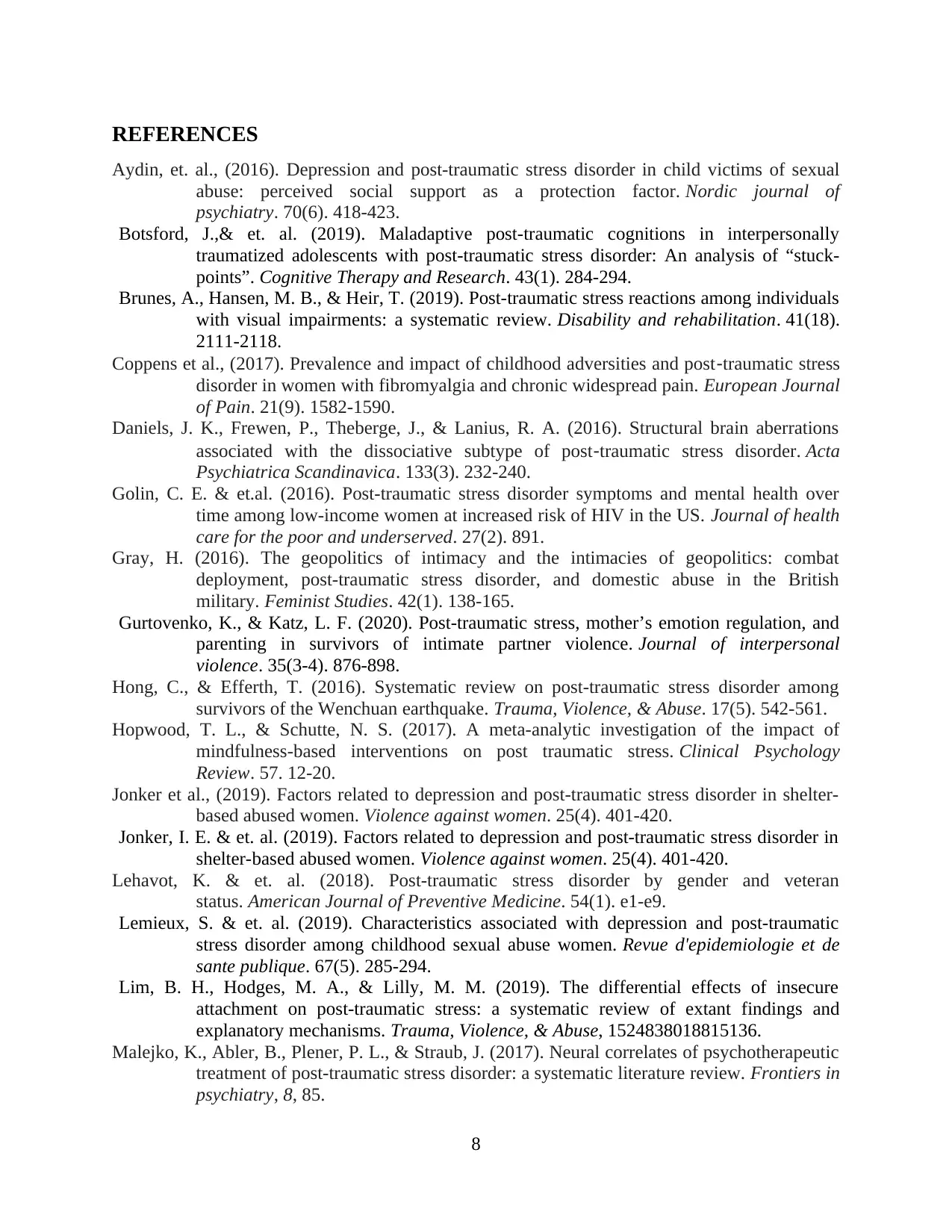
REFERENCES
Aydin, et. al., (2016). Depression and post-traumatic stress disorder in child victims of sexual
abuse: perceived social support as a protection factor. Nordic journal of
psychiatry. 70(6). 418-423.
Botsford, J.,& et. al. (2019). Maladaptive post-traumatic cognitions in interpersonally
traumatized adolescents with post-traumatic stress disorder: An analysis of “stuck-
points”. Cognitive Therapy and Research. 43(1). 284-294.
Brunes, A., Hansen, M. B., & Heir, T. (2019). Post-traumatic stress reactions among individuals
with visual impairments: a systematic review. Disability and rehabilitation. 41(18).
2111-2118.
Coppens et al., (2017). Prevalence and impact of childhood adversities and post‐traumatic stress
disorder in women with fibromyalgia and chronic widespread pain. European Journal
of Pain. 21(9). 1582-1590.
Daniels, J. K., Frewen, P., Theberge, J., & Lanius, R. A. (2016). Structural brain aberrations
associated with the dissociative subtype of post‐traumatic stress disorder. Acta
Psychiatrica Scandinavica. 133(3). 232-240.
Golin, C. E. & et.al. (2016). Post-traumatic stress disorder symptoms and mental health over
time among low-income women at increased risk of HIV in the US. Journal of health
care for the poor and underserved. 27(2). 891.
Gray, H. (2016). The geopolitics of intimacy and the intimacies of geopolitics: combat
deployment, post-traumatic stress disorder, and domestic abuse in the British
military. Feminist Studies. 42(1). 138-165.
Gurtovenko, K., & Katz, L. F. (2020). Post-traumatic stress, mother’s emotion regulation, and
parenting in survivors of intimate partner violence. Journal of interpersonal
violence. 35(3-4). 876-898.
Hong, C., & Efferth, T. (2016). Systematic review on post-traumatic stress disorder among
survivors of the Wenchuan earthquake. Trauma, Violence, & Abuse. 17(5). 542-561.
Hopwood, T. L., & Schutte, N. S. (2017). A meta-analytic investigation of the impact of
mindfulness-based interventions on post traumatic stress. Clinical Psychology
Review. 57. 12-20.
Jonker et al., (2019). Factors related to depression and post-traumatic stress disorder in shelter-
based abused women. Violence against women. 25(4). 401-420.
Jonker, I. E. & et. al. (2019). Factors related to depression and post-traumatic stress disorder in
shelter-based abused women. Violence against women. 25(4). 401-420.
Lehavot, K. & et. al. (2018). Post-traumatic stress disorder by gender and veteran
status. American Journal of Preventive Medicine. 54(1). e1-e9.
Lemieux, S. & et. al. (2019). Characteristics associated with depression and post-traumatic
stress disorder among childhood sexual abuse women. Revue d'epidemiologie et de
sante publique. 67(5). 285-294.
Lim, B. H., Hodges, M. A., & Lilly, M. M. (2019). The differential effects of insecure
attachment on post-traumatic stress: a systematic review of extant findings and
explanatory mechanisms. Trauma, Violence, & Abuse, 1524838018815136.
Malejko, K., Abler, B., Plener, P. L., & Straub, J. (2017). Neural correlates of psychotherapeutic
treatment of post-traumatic stress disorder: a systematic literature review. Frontiers in
psychiatry, 8, 85.
8
Aydin, et. al., (2016). Depression and post-traumatic stress disorder in child victims of sexual
abuse: perceived social support as a protection factor. Nordic journal of
psychiatry. 70(6). 418-423.
Botsford, J.,& et. al. (2019). Maladaptive post-traumatic cognitions in interpersonally
traumatized adolescents with post-traumatic stress disorder: An analysis of “stuck-
points”. Cognitive Therapy and Research. 43(1). 284-294.
Brunes, A., Hansen, M. B., & Heir, T. (2019). Post-traumatic stress reactions among individuals
with visual impairments: a systematic review. Disability and rehabilitation. 41(18).
2111-2118.
Coppens et al., (2017). Prevalence and impact of childhood adversities and post‐traumatic stress
disorder in women with fibromyalgia and chronic widespread pain. European Journal
of Pain. 21(9). 1582-1590.
Daniels, J. K., Frewen, P., Theberge, J., & Lanius, R. A. (2016). Structural brain aberrations
associated with the dissociative subtype of post‐traumatic stress disorder. Acta
Psychiatrica Scandinavica. 133(3). 232-240.
Golin, C. E. & et.al. (2016). Post-traumatic stress disorder symptoms and mental health over
time among low-income women at increased risk of HIV in the US. Journal of health
care for the poor and underserved. 27(2). 891.
Gray, H. (2016). The geopolitics of intimacy and the intimacies of geopolitics: combat
deployment, post-traumatic stress disorder, and domestic abuse in the British
military. Feminist Studies. 42(1). 138-165.
Gurtovenko, K., & Katz, L. F. (2020). Post-traumatic stress, mother’s emotion regulation, and
parenting in survivors of intimate partner violence. Journal of interpersonal
violence. 35(3-4). 876-898.
Hong, C., & Efferth, T. (2016). Systematic review on post-traumatic stress disorder among
survivors of the Wenchuan earthquake. Trauma, Violence, & Abuse. 17(5). 542-561.
Hopwood, T. L., & Schutte, N. S. (2017). A meta-analytic investigation of the impact of
mindfulness-based interventions on post traumatic stress. Clinical Psychology
Review. 57. 12-20.
Jonker et al., (2019). Factors related to depression and post-traumatic stress disorder in shelter-
based abused women. Violence against women. 25(4). 401-420.
Jonker, I. E. & et. al. (2019). Factors related to depression and post-traumatic stress disorder in
shelter-based abused women. Violence against women. 25(4). 401-420.
Lehavot, K. & et. al. (2018). Post-traumatic stress disorder by gender and veteran
status. American Journal of Preventive Medicine. 54(1). e1-e9.
Lemieux, S. & et. al. (2019). Characteristics associated with depression and post-traumatic
stress disorder among childhood sexual abuse women. Revue d'epidemiologie et de
sante publique. 67(5). 285-294.
Lim, B. H., Hodges, M. A., & Lilly, M. M. (2019). The differential effects of insecure
attachment on post-traumatic stress: a systematic review of extant findings and
explanatory mechanisms. Trauma, Violence, & Abuse, 1524838018815136.
Malejko, K., Abler, B., Plener, P. L., & Straub, J. (2017). Neural correlates of psychotherapeutic
treatment of post-traumatic stress disorder: a systematic literature review. Frontiers in
psychiatry, 8, 85.
8
Secure Best Marks with AI Grader
Need help grading? Try our AI Grader for instant feedback on your assignments.

Miragoli, S., Camisasca, E., & Di Blasio, P. (2017). Narrative fragmentation in child sexual
abuse: The role of age and post-traumatic stress disorder. Child abuse & neglect. 73.
106-114.
O'Driscoll, C., & Flanagan, E. (2016). Sexual problems and post‐traumatic stress disorder
following sexual trauma: A meta‐analytic review. Psychology and Psychotherapy:
Theory, Research and Practice. 89(3). 351-367.
Pape et al., (2018). DNA methylation levels are associated with CRF 1 receptor antagonist
treatment outcome in women with post-traumatic stress disorder. Clinical
epigenetics. 10(1). 1-11.
Rubin, L. H. & et. al. (2016). Post-traumatic stress is associated with verbal learning, memory,
and psychomotor speed in HIV-infected and HIV-uninfected women. Journal of
neurovirology. 22(2). 159-169.
Ryu, W., & Park, S. W. (2018). Post-traumatic stress disorder and social isolation among North
Korean refugee women in South Korea: The moderating role of formal and informal
support. Sustainability. 10(4). 1246.
Sanchez et. al., (2017). Childhood physical and sexual abuse experiences associated with post-
traumatic stress disorder among pregnant women. Annals of epidemiology. 27(11).
716-723.
Seow, L. & et. al. (2016). A systematic review on comorbid post-traumatic stress disorder in
schizophrenia. Schizophrenia Research. 176(2-3). 441-451.
Simpson, M., Schmied, V., Dickson, C., & Dahlen, H. G. (2018). Postnatal post-traumatic stress:
An integrative review. Women and Birth. 31(5). 367-379.
Tehrani, N. (2016). Extraversion, neuroticism and secondary trauma in Internet child abuse
investigators. Occupational medicine. 66(5). 403-407.
9
abuse: The role of age and post-traumatic stress disorder. Child abuse & neglect. 73.
106-114.
O'Driscoll, C., & Flanagan, E. (2016). Sexual problems and post‐traumatic stress disorder
following sexual trauma: A meta‐analytic review. Psychology and Psychotherapy:
Theory, Research and Practice. 89(3). 351-367.
Pape et al., (2018). DNA methylation levels are associated with CRF 1 receptor antagonist
treatment outcome in women with post-traumatic stress disorder. Clinical
epigenetics. 10(1). 1-11.
Rubin, L. H. & et. al. (2016). Post-traumatic stress is associated with verbal learning, memory,
and psychomotor speed in HIV-infected and HIV-uninfected women. Journal of
neurovirology. 22(2). 159-169.
Ryu, W., & Park, S. W. (2018). Post-traumatic stress disorder and social isolation among North
Korean refugee women in South Korea: The moderating role of formal and informal
support. Sustainability. 10(4). 1246.
Sanchez et. al., (2017). Childhood physical and sexual abuse experiences associated with post-
traumatic stress disorder among pregnant women. Annals of epidemiology. 27(11).
716-723.
Seow, L. & et. al. (2016). A systematic review on comorbid post-traumatic stress disorder in
schizophrenia. Schizophrenia Research. 176(2-3). 441-451.
Simpson, M., Schmied, V., Dickson, C., & Dahlen, H. G. (2018). Postnatal post-traumatic stress:
An integrative review. Women and Birth. 31(5). 367-379.
Tehrani, N. (2016). Extraversion, neuroticism and secondary trauma in Internet child abuse
investigators. Occupational medicine. 66(5). 403-407.
9
1 out of 11
Related Documents
Your All-in-One AI-Powered Toolkit for Academic Success.
+13062052269
info@desklib.com
Available 24*7 on WhatsApp / Email
![[object Object]](/_next/static/media/star-bottom.7253800d.svg)
Unlock your academic potential
© 2024 | Zucol Services PVT LTD | All rights reserved.





